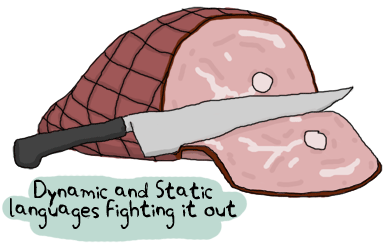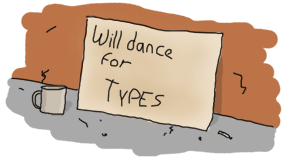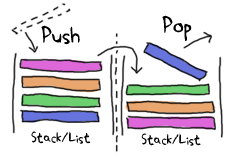Types (or lack thereof)
Dynamite-strong Typing
As you might have noticed when typing in examples from Starting Out (for real), and then modules and functions from Modules and Syntax in Functions, we never needed to write the type of a variable or the type of a function. When pattern matching, the code we had written didn't have to know what it would be matched against. The tuple {X,Y} could be matched with {atom, 123} as well as {"A string", <<"binary stuff!">>}, {2.0, ["strings","and",atoms]} or really anything at all.
When it didn't work, an error was thrown in your face, but only once you ran the code. This is because Erlang is dynamically typed: every error is caught at runtime and the compiler won't always yell at you when compiling modules where things may result in failure, like in Starting Out (for real)'s "llama + 5" example.

One classic friction point between proponents of static and dynamic typing has to do with the safety of the software being written. A frequently suggested idea is that good static type systems with compilers enforcing them with fervor will catch most errors waiting to happen before you can even execute the code. As such, statically typed languages are to be seen as safer than their dynamic counterparts. While this might be true when comparing with many dynamic languages, Erlang begs to differ and certainly has a track record to prove it. The best example is the often reported nine nines (99.9999999%) of availability offered on the Ericsson AXD 301 ATM switches, consisting of over 1 million lines of Erlang code. Please note that this is not an indication that none of the components in an Erlang-based system failed, but that a general switch system was available 99.9999999% of the time, planned outages included. This is partially because Erlang is built on the notion that a failure in one of the components should not affect the whole system. Errors coming from the programmer, hardware failures or [some] network failures are accounted for: the language includes features which will allow you to distribute a program over to different nodes, handle unexpected errors, and never stop running.
To make it short, while most languages and type systems aim to make a program error-free, Erlang uses a strategy where it is assumed that errors will happen anyway and makes sure to cover these cases: Erlang's dynamic type system is not a barrier to reliability and safety of programs. This sounds like a lot of prophetic talking, but you'll see how it's done in the later chapters.
Note: Dynamic typing was historically chosen for simple reasons; those who implemented Erlang at first mostly came from dynamically typed languages, and as such, having Erlang dynamic was the most natural option to them.
Erlang is also strongly typed. A weakly typed language would do implicit type conversions between terms. If Erlang were to be weakly typed we could possibly do the operation 6 = 5 + "1". while in practice, an exception for bad arguments will be thrown:
1> 6 + "1".
** exception error: bad argument in an arithmetic expression
in operator +/2
called as 6 + "1"
Of course, there are times when you could want to convert one kind of data to another one: changing regular strings into bit strings to store them or an integer to a floating point number. The Erlang standard library provides a number of functions to do it.
Type conversions
Erlang, like many languages, changes the type of a term by casting it into another one. This is done with the help of built-in functions, as many of the conversions could not be implemented in Erlang itself. Each of these functions take the form <type>_to_<type> and are implemented in the erlang module. Here are a few of them:
1> erlang:list_to_integer("54").
54
2> erlang:integer_to_list(54).
"54"
3> erlang:list_to_integer("54.32").
** exception error: bad argument
in function list_to_integer/1
called as list_to_integer("54.32")
4> erlang:list_to_float("54.32").
54.32
5> erlang:atom_to_list(true).
"true"
6> erlang:list_to_bitstring("hi there").
<<"hi there">>
7> erlang:bitstring_to_list(<<"hi there">>).
"hi there"
And so on. We're hitting on a language wart here: because the scheme <type>_to_<type> is used, every time a new type is added to the language, a whole lot of conversion BIFs need to be added! Here's the whole list already there:
atom_to_binary/2, atom_to_list/1, binary_to_atom/2, binary_to_existing_atom/2, binary_to_list/1, bitstring_to_list/1, binary_to_term/1, float_to_list/1, fun_to_list/1, integer_to_list/1, integer_to_list/2, iolist_to_binary/1, iolist_to_atom/1, list_to_atom/1, list_to_binary/1, list_to_bitstring/1, list_to_existing_atom/1, list_to_float/1, list_to_integer/2, list_to_pid/1, list_to_tuple/1, pid_to_list/1, port_to_list/1, ref_to_list/1, term_to_binary/1, term_to_binary/2 and tuple_to_list/1.
That's a lot of conversion functions. We'll see most if not all of these types through this book, although we probably won't need all of these functions.
To Guard a Data Type
Erlang basic data types are easy to spot, visually: tuples have the curly brackets, lists the square brackets, strings are enclosed in double quotation marks, etc. Enforcing a certain data type has thus been possible with pattern matching: a function head/1 taking a list could only accept lists because otherwise, the matching ([H|_]) would have failed.

However, we've had a problem with numeric values because we couldn't specify ranges. Consequently, we used guards in functions about temperature, the age to drive, etc. We're hitting another roadblock now. How could we write a guard that ensures that patterns match against data of a single specific type, like numbers, atoms or bitstrings?
There are functions dedicated to this task. They will take a single argument and return true if the type is right, false otherwise. They are part of the few functions allowed in guard expressions and are named the type test BIFs:
is_atom/1 is_binary/1 is_bitstring/1 is_boolean/1 is_builtin/3 is_float/1 is_function/1 is_function/2 is_integer/1 is_list/1 is_number/1 is_pid/1 is_port/1 is_record/2 is_record/3 is_reference/1 is_tuple/1
They can be used like any other guard expression, wherever guard expressions are allowed. You might be wondering why there is no function just giving the type of the term being evaluated (something akin to type_of(X) -> Type). The answer is pretty simple. Erlang is about programming for the right cases: you only program for what you know will happen and what you expect. Everything else should cause errors as soon as possible. Although this might sound insane, the explanations you'll get in Errors and Exceptions will hopefully make things clearer. Until then, just trust me on that.
Note: type test BIFs constitute more than half of the functions allowed in guard expressions. The rest are also BIFs, but do not represent type tests. These are:
abs(Number), bit_size(Bitstring), byte_size(Bitstring), element(N, Tuple), float(Term), hd(List), length(List), node(), node(Pid|Ref|Port), round(Number), self(), size(Tuple|Bitstring), tl(List), trunc(Number), tuple_size(Tuple).
The functions node/1 and self/0 are related to distributed Erlang and processes/actors. We'll eventually use them, but we've still got other topics to cover before then.
It may seem like Erlang data structures are relatively limited, but lists and tuples are usually enough to build other complex structures without worrying about anything. As an example the basic node of a binary tree could be represented as {node, Value, Left, Right}, where Left and Right are either similar nodes or empty tuples. I could also represent myself as:
{person, {name, <<"Fred T-H">>},
{qualities, ["handsome", "smart", "honest", "objective"]},
{faults, ["liar"]},
{skills, ["programming", "bass guitar", "underwater breakdancing"]}}.
Which shows that by nesting tuples and list and filling them with data, we can obtain complex data structures and build functions to operate on them.
Update:
The release R13B04 saw the addition of the BIF binary_to_term/2, which lets you unserialize data the same way binary_to_term/1 would, except the second argument is an option list. If you pass in [safe], the binary won't be decoded if it contains unknown atoms or anonymous functions, which could exhaust memory.
For Type Junkies

This section is meant to be read by programmers who can not live without a static type system for one reason or another. It will include a little bit more advanced theory and everything may not be understood by everyone. I will briefly describe tools used to do static type analysis in Erlang, defining custom types and getting more safety that way. These tools will be described for anyone to understand much later in the book, given that it is not necessary to use any of them to write reliable Erlang programs. Because we'll show them later, I'll give very little details about installing, running them, etc. Again, this section is for those who really can't live without advanced type systems.
Through the years, there were some attempts to build type systems on top of Erlang. One such attempt happened back in 1997, conducted by Simon Marlow, one of the lead developers of the Glasgow Haskell Compiler, and Philip Wadler, who worked on Haskell's design and has contributed to the theory behind monads (Read the paper on said type system). Joe Armstrong later commented on the paper:
One day Phil phoned me up and announced that a) Erlang needed a type system, b) he had written a small prototype of a type system and c) he had a one year’s sabbatical and was going to write a type system for Erlang and “were we interested?” Answer —“Yes.”
Phil Wadler and Simon Marlow worked on a type system for over a year and the results were published in [20]. The results of the project were somewhat disappointing. To start with, only a subset of the language was type-checkable, the major omission being the lack of process types and of type checking inter-process messages.
Processes and messages both being one of the core features of Erlang, it may explain why the system was never added to the language. Other attempts at typing Erlang failed. The efforts of the HiPE project (attempts to make Erlang's performances much better) produced Dialyzer, a static analysis tool still in use today, with its very own type inference mechanism.
The type system that came out of it is based on success typings, a concept different from Hindley-Milner or soft-typing type systems. Success types are simple in concept: the type-inference will not try to find the exact type of every expression, but it will guarantee that the types it infers are right, and that the type errors it finds are really errors.
The best example would come from the implementation of the function and, which will usually take two Boolean values and return 'true' if they're both true, 'false' otherwise. In Haskell's type system, this would be written and :: bool -> bool -> bool. If the and function had to be implemented in Erlang, it could be done the following way:
and(false, _) -> false; and(_, false) -> false; and(true,true) -> true.
Under success typing, the inferred type of the function would be and(_,_) -> bool(), where _ means 'anything'. The reason for this is simple: when running an Erlang program and calling this function with the arguments false and 42, the result would still be 'false'. The use of the _ wildcard in pattern matching made it that in practice, any argument can be passed as long as one of them is 'false' for the function to work. ML types would have thrown a fit (and its users had a heart attack) if you had called the function this way. Not Erlang. It might make more sense to you if you decide to read the paper on the implementation of success types, which explains the rationale behind the behavior. I really encourage any type junkies out there to read it, it's an interesting and practical implementation definition.
The details about type definitions and function annotations are described in the Erlang Enhancement Proposal 8 (EEP 8). If you're interested in using success typings in Erlang, check out the TypEr application and Dialyzer, both part of the standard distribution. To use them, type in $ typer --help and $ dialyzer --help (typer.exe --help and dialyzer.exe --help for Windows, if they're accessible from the directory you are currently in).
TypEr will be used to generate type annotations for functions. Used on this small FIFO implementation, it spits the following type annotations:
%% File: fifo.erl
%% --------------
-spec new() -> {'fifo',[],[]}.
-spec push({'fifo',_,_},_) -> {'fifo',nonempty_maybe_improper_list(),_}.
-spec pop({'fifo',_,maybe_improper_list()}) -> {_,{'fifo',_,_}}.
-spec empty({'fifo',_,_}) -> bool().

Which is pretty much right. Improper lists should be avoided because lists:reverse/1 doesn't support them, but someone bypassing the module's interface would be able to get through it and submit one. In this case, the functions push/2 and pop/2 might still succeed for a few calls before they cause an exception. This either tells us to add guards or refine our type definitions manually. Suppose we add the signature -spec push({fifo,list(),list()},_) -> {fifo,nonempty_list(),list()}. and a function that passes an improper list to push/2 to the module: when scanning it in Dialyzer (which checks and matches the types), the error message "The call fifo:push({fifo,[1|2],[]},3) breaks the contract '<Type definition here>' is output.
Dialyzer will complain only when code will break other code, and if it does, it'll usually be right (it will complain about more stuff too, like clauses that will never match or general discrepancies). Polymorphic data types are also possible to write and analyze with Dialyzer: the hd() function could be annotated with -spec([A]) -> A. and be analyzed correctly, although Erlang programmers seem to rarely use this type syntax.
Don't drink too much Kool-Aid:
Some of the things you can't expect Dialyzer and TypEr to do is type classes with constructors, first order types and recursive types. The types of Erlang are only annotations without effects or restrictions on actual compiling unless you enforce them yourself. The type checker will never tell you a program that can run right now (or has run for two years) has a type bug when it effectively causes no error when running (although you could have buggy code running correctly...)
While recursive types are something that would be really interesting to have, they're unlikely to ever appear in the current forms of TypEr and Dialyzer (the paper above explains why). Defining your own types to simulate recursive types by adding one or two levels manually is the best you can do at the moment.
It's certainly not a full-blown type system, not as strict or powerful as what languages like Scala, Haskell or Ocaml propose. Its warning and error messages are also usually a bit cryptic and not really user friendly. However, it's still a very good compromise if you really can't live in a dynamic world or wish for additional safety; just expect it to be a tool in your arsenal, not too much more.
Update:
Since version R13B04, recursive types are now available as an experimental feature for Dialyzer. This makes the previous Don't drink too much Kool-aid partially wrong. Shame on me.
Note that the type documentation has also become official (although it remains subject to change) and is more complete than what can be found in EEP8.